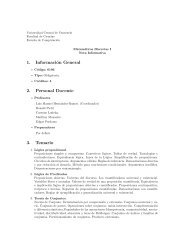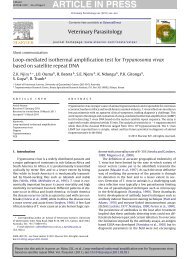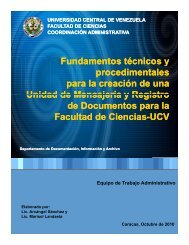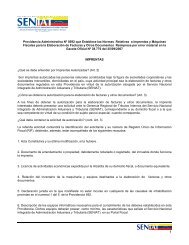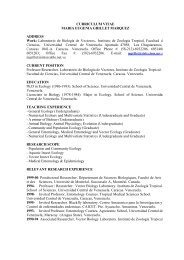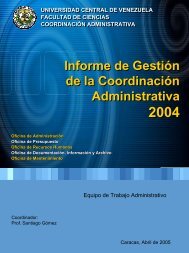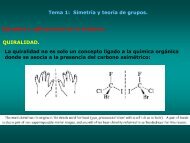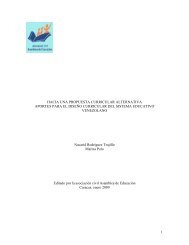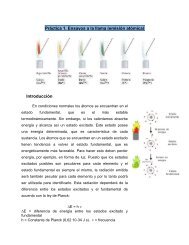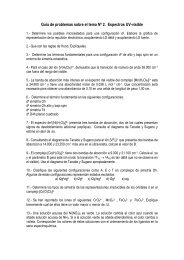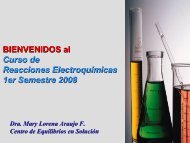Collecting and Preserving
Collecting and Preserving
Collecting and Preserving
- No tags were found...
You also want an ePaper? Increase the reach of your titles
YUMPU automatically turns print PDFs into web optimized ePapers that Google loves.
specimens may be badly rubbed or torn. If only smallinsects are desired, they may be protected from damage bylarger insects by placing a screen with the proper sizedmesh over the entrance. The Minnesota trap is very similarto the New Jersey trap, but it does not include a fan or anymotorized method of draft induction.The Wilkinson trap (fig. 14) requires somewhatmore effort to construct than the preceding traps, but it hasthe advantage of confining, not killing, the trapped insects.Moths, therefore, can be collected in good condition if thetrap is inspected frequently <strong>and</strong> desirable specimens areremoved quickly through the hinged top <strong>and</strong> placed in akilling jar.Several highly effective but more elaborate deviceshave been made for collecting moths <strong>and</strong> other fragileinsects in good condition. Basically, they all use theprinciple of a funnel with a central light source above it<strong>and</strong> vanes or baffles to intercept the approaching insectsthat are dropped through the funnel into the containerbeneath, which may or may not hold a killing agent. Thenature of the container <strong>and</strong> the type of killing agent affectthe quality of the specimens obtained. Some traps catchthe insects alive in a large collection chamber, such as agarbage can, which is filled or nearly filled with looselyarranged egg cartons. Most moths will come to rest in thecavities between the egg cartons <strong>and</strong> will remain thereuntil removed in the morning.Other traps are designed to kill the insects by meansof high concentrations of fumes from a liquid killingagent, such as tetrachloroethane or calcium cyanide. Aheaping tablespoon or more of calcium cyanide is placedin each of four to six brown paper bags, which are hung ina large garbage can or other large container. A dampenedcloth, such as a washcloth, is also hung inside the can tohumidify the air <strong>and</strong> activate the cyanide. This is especiallynecessary in dry weather. The concentration of thegas inside the can is so great that insects are inactivatedalmost instantly on entering, <strong>and</strong> even the most delicatespecimens are damaged very little. The bags containing thecalcium cyanide powder should be replaced as needed. Iftwo of the oldest bags are replaced with two fresh oneseach successive night, the trap can be run as long as thecollector desires.H<strong>and</strong>le cyanide outdoors, facing downwind, <strong>and</strong>with extreme caution. During the day, when the trap is notin use, store the cyanide bags in an airtight container. Allforms of cyanide used as killing agents react <strong>and</strong> breakdown quickly when exposed to air <strong>and</strong> moisture; neverthelessdispose of the residue carefully.To prevent rainwater from accumulating in the trap,place a screen-covered funnel inside the collectionchamber to drain the water out through a hole in theTechniques <strong>and</strong> Toolsbottom of the trap. Sometimes a system of separators isadded to guide beetles <strong>and</strong> other heavy, hard-bodiedinsects into a different part of the container than the moths<strong>and</strong> other delicate specimens.The most efficient light traps use lamps rich in theiroutput of ultraviolet light. The British-made Robinson trapemploys an intense, blue-white, 125-watt mercury vaporlamp of a type used for street lighting. This, the mosteffective insect attractant commercially marketed, iswidely used in many kinds of light traps because it hassome special advantages over other kinds of attractants.For example, this type of lamp is the only one that emitsthe kind of light that attracts large numbers of Catocala(underwing) moths, a colorful group popular with manycollectors.Many traps are equipped with 15-watt ultravioletfluorescent tubes, which emit a highly visible bluish-whitelight, although blacklight tubes emitting deep purple lightare similarly effective. Ultraviolet tubes of lower or higherwattage also may be used <strong>and</strong> are all highly effective. A15-watt ultraviolet tube has been estimated to attract about10 times as many insects as a 500 c<strong>and</strong>lepower gasolinelantern or inc<strong>and</strong>escent lamp. The advantage of thefluorescent tube over the mercury vapor lamp is that it isless expensive <strong>and</strong> much more portable. A 15-watt tube iseasily powered by an ordinary automobile battery by usingan inverter to change 6- or 12-volt direct current to 120-volt alternating current. Also, its ultraviolet output is notstrong enough to cause any significant eye damage. Thesafety factor of the mercury vapor lamp at close range isless certain, although entomologists who have used theRobinson trap for many years seem to have suffered no illeffects.A new, lightweight, spillproof 12-volt battery, inwhich the acid electrolyte is a gel rather than a liquid, isfar superior to the st<strong>and</strong>ard automotive battery for poweringlight traps, but it is fairly expensive <strong>and</strong> requires aspecial charger. Special lightweight, nickel-cadmiumbattery packs, used to power blacklights for collecting, aremarketed by some dealers of entomological equipment.1.10.10 Light SheetsAnother highly effective method of using light toattract moths <strong>and</strong> other nocturnal insects is with a lightsheet (fig. 15). This is simply a cloth sheet, usually a whitebedsheet, hung outdoors at night with an appropriate lightsource or combination of sources such as ultravioletfluorescent tubes, gasoline lanterns, or automobileheadlights placed a few feet in front of it. As insects areattracted <strong>and</strong> alight on the sheet, they are easily captured incyanide bottles or jars by the collector who st<strong>and</strong>s inattendance or at least checks the sheet frequently. The17



